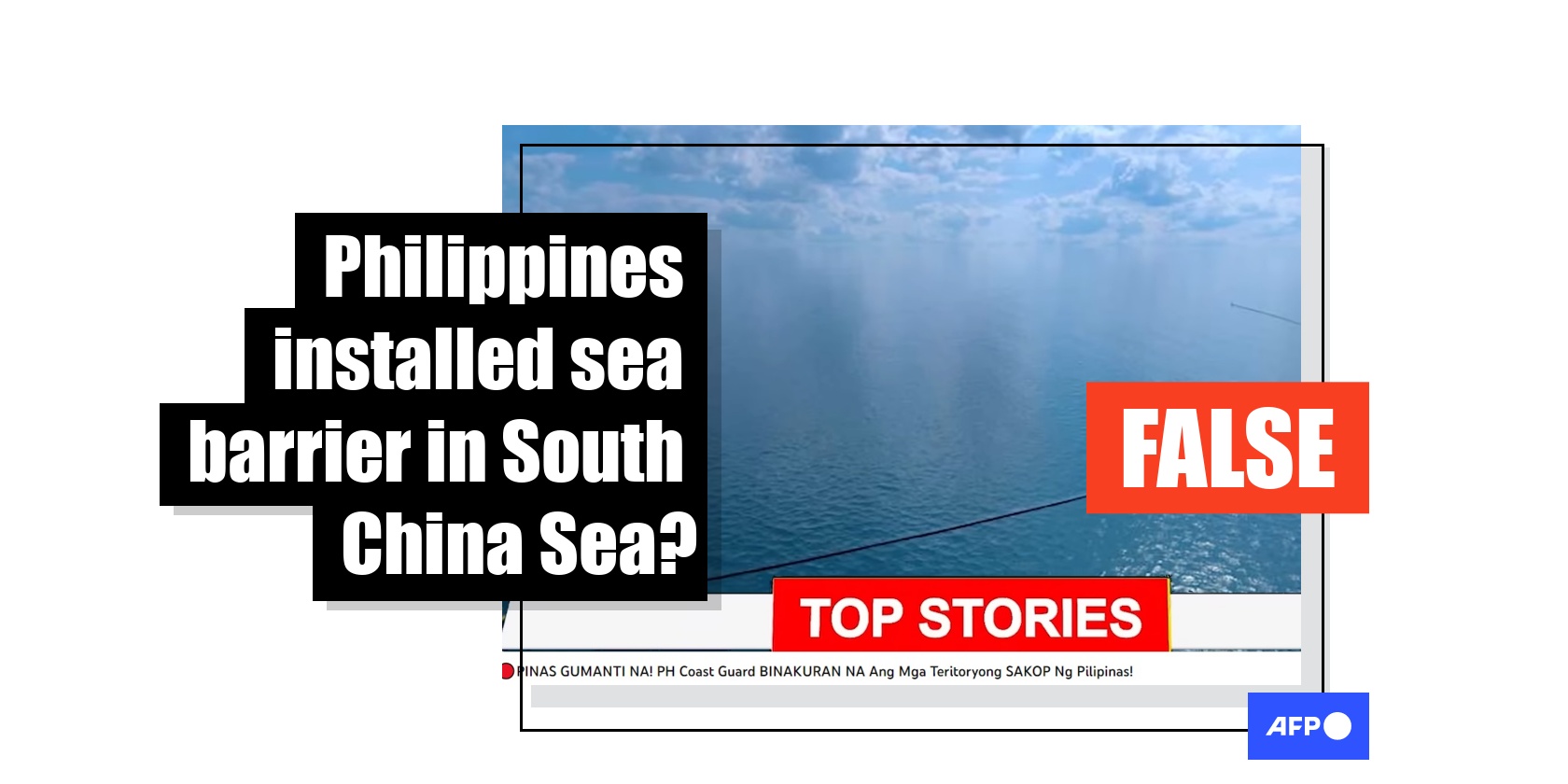
Fabricated report claims Philippines set up barriers in disputed sea after China row
- This article is more than two years old.
- Published on October 17, 2023 at 11:02
- 4 min read
- By Jan Cuyco, AFP Philippines
"The Philippines takes revenge! PH Coast Guard has fenced the territories claimed by the Philippines!" reads the Tagalog title of a YouTube video shared on September 27.
It has racked up over 260,000 views after being published in a channel with a history of producing fabricated reports about the South China Sea.
Designed like a news report, the video features a narrator saying the Philippine Coast Guard installed the devices at Flat Island, Loaita Island, Loaita Cay and at fishing grounds in Irving and Whitsun Reef on September 10 to 12.
"This is the answer of the Philippines to the Chinese," the narrator says as the video shows images of floating objects that form a barrier in the sea.
It then flashes a clip of Philippine Coast Guard personnel cutting a rope attached to white buoys earlier installed by China at Scarborough Shoal. The incident ignited a war of words between the countries.
China, which claims almost the entire South China Sea, seized the reef from the Philippines in 2012.
Since then, Beijing has deployed patrol boats that Manila says harass Philippine vessels and prevent Filipino fishermen from reaching the lagoon where fish are more plentiful.

The video has also been shared here, here and here on Facebook.
However, no credible news reports following China's installation of a sea barrier at Scarborough Shoal indicate the Philippines set up similar barriers in response.
'Navigational buoys'
The Philippine Coast Guard had actually deployed "navigational buoys" in the five areas mentioned in the video in May -- not in September.
Philippine Coast Guard spokesman for the West Philippine Sea Jay Tarriela told AFP on October 13 the agency installed "navigational buoys on the critical areas of West Philippine Sea -- Patag Island, Balagtas Reef, Kota Island, Panata Island and Juan Felipe Reef from 10-12 May 2023."
Tarriela used the Philippine names for the features in the Spratly Islands located over 530 kilometres (330 miles) away from Scarborough Shoal.
Manila refers to waters immediately to its west as the West Philippine Sea.
Tarriela announced the installation of the buoys on X, formerly Twitter on May 14, 2023 (archived link).
The photos he shared in his statement show upright yellow pillars -- not the long barrier-like devices shown in the fabricated report:

Local media here, here and here also reported on the development at the time (archived links here, here and here).
Edcel John Ibarra, an assistant professor of political science at the University of the Philippines Diliman, said the buoys are different from the barrier China had installed.
"Navigational buoys act like small floating lighthouses, while floating barriers act like floating walls. Buoys aid in navigation; barriers prevent it," he told AFP on October 4.
Misused images
Moreover, Google reverse searches found the images featured in the false video were in fact taken from unrelated sources.
The first photo was published on September 7, 2018 by US science media outlet ScienceNews which said it shows a computer-generated image of a device designed to collect plastic waste in the ocean (archived link).
"A computer rendering depicts the entire 600-meter-long Ocean Cleanup system floating in the North Pacific, as currents push the edges of the boom to form a u-shape," reads the photo's caption.
Below is a screenshot comparison of the photo used in the video (left) and the photo from the ScienceNews report (right):

The photo was also published on October 17, 2018 by US-based news outlet Hawaii News Now (archived link).
The second image was published on a website called Inhabitat on October 10, 2014 (archived link).
The article features a system of floating barriers attached to the seabed and oriented in a V-shape, allowing it to extract plastic waste from the Great Pacific Garbage Patch.

An identical photo was used in an article by architectural magazine Dezeen on April 2, 2015 (archived link).
Three other clips were taken from a YouTube video published by GEI Works -- a company based in the United States that manufactures environmental products -- on October 16, 2015 (archived links here and here).
The video is titled, "Sargassum Seaweed Floating Barrier | Protect your Beaches".

A spokesperson for GEI Works told AFP on October 10 clips show an "installation of a Sargassum Barrier done by GEI Works in the Carribbean at a resort".
Another three images were lifted from websites that sell maritime equipment -- including floating barriers -- as seen here, here and here (archived links here, here and here).

AFP has repeatedly debunked misinformation about the South China Sea here, here and here.
Copyright © AFP 2017-2025. Any commercial use of this content requires a subscription. Click here to find out more.
Is there content that you would like AFP to fact-check? Get in touch.
Contact us
